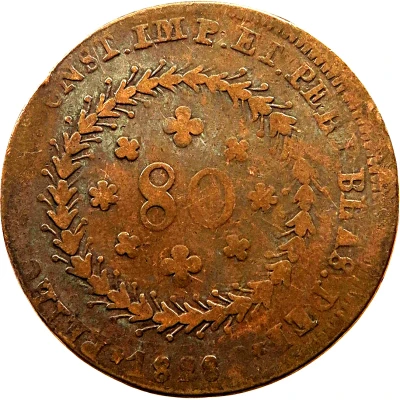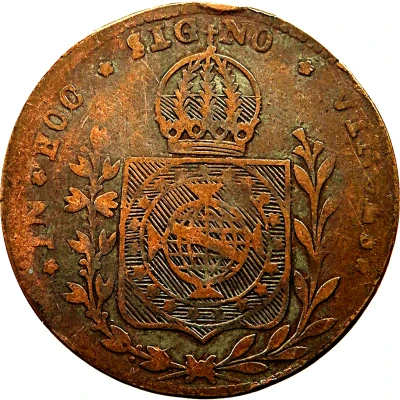


© Rafael Augusto de Mattos Ferreira
80 Réis - Pedro I
| Copper | 14.34 g | 37 mm |
| Issuer | Brazil |
|---|---|
| Emperor | Peter I the Liberator (1822-1831) |
| Type | Standard circulation coin |
| Years | 1826-1831 |
| Value | 80 Réis |
| Currency | Real (1799-1942) |
| Composition | Copper |
| Weight | 14.34 g |
| Diameter | 37 mm |
| Thickness | 1.6 mm |
| Shape | Round |
| Technique | Milled |
| Orientation | Medal alignment ↑↑ |
| Demonetized | 4 October 1942 |
| Updated | 2024-10-04 |
| Numista | N#127770 |
|---|---|
| Rarity index | 83% |
Reverse
Crowned Coat of Arms, motto above and sides.
Escudo coronado, lema arriba y a los lados.
Script: Latin
Lettering: IN HOC SIGNO VINCES
Translation:
In this sign you will conquer
Por este signo vencerás.
Edge
Smooth
Liso
Comment
C = Cuiabá (KM# 377.1)Mint of Cuiabá
According to some scholars, it was nothing more than a mere monetary workshop, attached to the Foundry House of that city. It was not limited to just reaping existing coins; produced new currency, copper, marked with monetary letter "C".
Its duration was also quite long, having documents about its existence dated of 1753 and 1833. Probably accompanied the change of the administration of Cuiaba from Vila Bela of the Saint Trinity of Mato Grosso, in 1772. In that case, it would have flooded the Cuiabá in 1819. In 1828 still had 10 employees and was separated from the Foundry House.
G = Goiás (KM# 377.2 and 377.3)
Foundry House of Goiás
Created in 1752, it had delayed the beginning of its activities. On May 21, 1753, it had not yet begun to operate, as can be seen from the proposal made by the then Governor D. Marcos Noronha to the Câmara de Goiás, requesting that the capitation be continued until Cassa "in terms of working". Terida was probably abolished in 1823. The Goiás Foundry House was installed in a building purchased by Domingos Lopes Fogaça for 6,333 gold octaves, the equivalent today at current gold prices of 250,000 dollars.